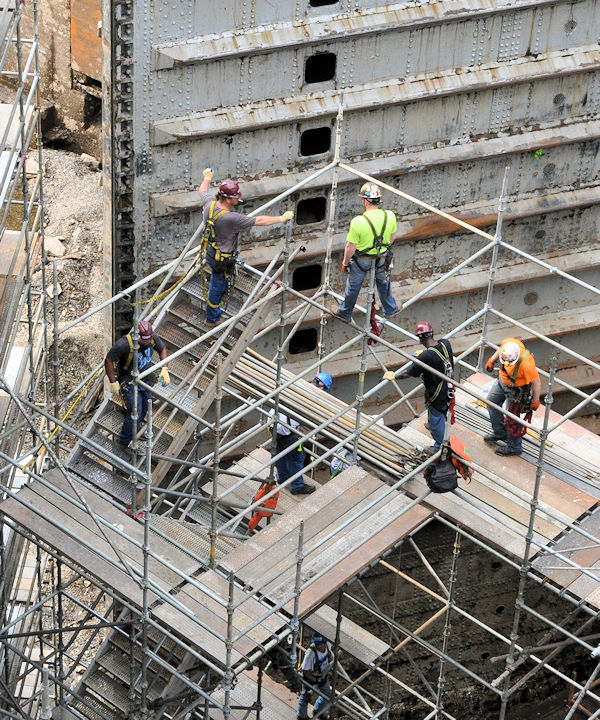22.B.18 Access.
- An access ladder or equivalent safe access must be provided.
- Where a built-in ladder is part of a scaffold system, it must conform to the requirements for ladders. > See Section 24.B.
- Climbing of braces is prohibited.
- When hook-on or attachable ladders are used on a supported scaffold more than 20 ft (6 m) in height, they must have rest platforms every 20 ft or fall protection will be used. If scaffold platforms are used as rest platforms they will be arranged so the climber must exit to a platform before climbing the next section of ladder. When end frames are used for access they will conform to the ladder standard and not exceed 20 ft without FP.
- Hook-on or attachable ladders must be specifically designed for use with the type of scaffold and they must be positioned so as not to tip the scaffold.
- When erecting or dismantling welded frame scaffolds, the end frames may be used as access provided the horizontal members are not more than 22 in (55.9 cm) apart.
- The minimum clear length of the rungs must be 16 in (40.7 cm).
- The distance from the supporting surface to the first step of a ladder, stair, or frame designed to be climbed must not exceed 2 ft (61 cm).
- Ladder access points must be protected by an inward swinging gate or chain guard.
22 B.19 Where the scaffold height exceeds four times the minimum scaffold base dimension (and including the width added by outriggers, if used), the scaffold must be secured to the wall or structure.
- The first vertical and horizontal tie must be placed at this point.
- Vertical ties must be repeated at intervals not greater than 26 ft (7.9 m) with the top tie placed no lower than four times the base dimension from the top of the scaffold.
- Horizontal ties must be placed at each end and at intervals not greater than 30 ft (9.1 m).
- When more stringent means of securing the scaffold are recommended by the manufacturer or an RPE, the more stringent requirements must be followed.
22.B.20 When scaffolds are to be partially or fully enclosed, a QP must verify the adequacy of the number, placement, and strength of ties attaching the scaffold to the structure, taking into consideration wind loads and weather.
22.B.21 When vehicles or mobile equipment are used or allowed adjacent to scaffolding, substantial stop logs or barricades must be installed.
- The use of a ground guide is recommended for this equipment, however, if it is demonstrated that barricades are not feasible or are not required based on distance, a ground guide must be used.
- Ground guides must not be exposed to potential falling objects from the scaffold or the equipment.
- Hanging scaffolds are exempt unless the CP determines that vehicles or mobile equipment could pose a hazard to safe operation.
22.B.22 The use of brackets on scaffolds must be prohibited unless the tipping effect is controlled.
22.B.23 Use of the following types of scaffolding is permitted if they are designed and constructed in accordance with ANSI A10.8:
- Outrigger scaffolds;
- Needle beam scaffolds;
- Interior hung scaffolds;
- Bricklayer's square scaffolds;
- Float/ship scaffolds;
- Boatswain's scaffolds;
- Window jack scaffolds;
- Carpenter's bracket scaffolds, and
- Form scaffolds.
22.B.24 Other types of scaffolding not included in ANSI A10.8 may be approved by the GDA provided the design is approved by a Registered Professional Engineer (RPE) or it meets a nationally recognized design standard.
Knowledge Check Choose the best answer for the question.
22-5. When must the scaffold be secured to a wall or structure?
You forgot to answer the question!

